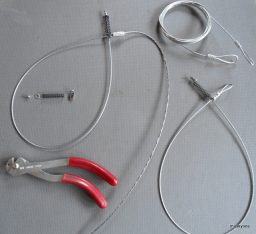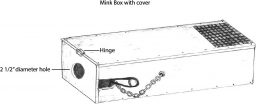What Should You Do If You Catch A Non-target Animal In A Trap?

Responsible and humane harvest of furbearers is a primary objective for all trapping activities and is guided by legislation and standards of behave that have been developed over time with input of trappers and wildlife managers. Whether your trapping pursuits involve setting snares for fox, coyote, wolf or lynx, using body grippers for mink or marten (Labrador) or using water sets for aquatic furbearers, choosing the appropriate location for your set is an important consideration to aid avoid capturing animals that are not legal to trap. Like to Best Direction Practices for Newfoundland Marten (page 43-44) there are likewise a number of trap designs and/or adaptations to existing gear that trappers can use generally to avoid accidental and sometimes lethal capture of non-target animals.
 Break-abroad devices such as "S" or "J" hooks placed on fox, coyote, lynx or wolf snares is an easy adaptation that trappers who build their ain snares can use to potentially reduce capture of wildlife such every bit moose, caribou and black bears or free ranging livestock. This is achieved by adding a "J" claw to the base of operations of a slide-lock or "Due south" claw to a cam blazon lock or past calculation a breakaway release ferrule (BAW) to the finish of snare. The S, J hook or BAW ferrule retains plenty strength to capture the intended beast but the strength of larger animals will break the claw or breakaway ferrule and permit them to escape relatively unharmed. Purchasing snares constructed in this fashion from trapping suppliers is widely bachelor. Calculation a stop to the snare and then that information technology is still effective for capturing furbearers only allows a moose or caribou'due south leg to slip through is besides beneficial. In that location is some variability in the cost and effectiveness of break-away devices that trappers will need to consider, particularly for larger furbearers such every bit wolves. The end result, however, is that these devices tin make a deviation towards protecting wild fauna or livestock that are not meant to exist captured in the first place. Acquire more about their use past contacting trapping supply retailers, the Newfoundland and Labrador Trappers Association or the Wild animals Partition.
Break-abroad devices such as "S" or "J" hooks placed on fox, coyote, lynx or wolf snares is an easy adaptation that trappers who build their ain snares can use to potentially reduce capture of wildlife such every bit moose, caribou and black bears or free ranging livestock. This is achieved by adding a "J" claw to the base of operations of a slide-lock or "Due south" claw to a cam blazon lock or past calculation a breakaway release ferrule (BAW) to the finish of snare. The S, J hook or BAW ferrule retains plenty strength to capture the intended beast but the strength of larger animals will break the claw or breakaway ferrule and permit them to escape relatively unharmed. Purchasing snares constructed in this fashion from trapping suppliers is widely bachelor. Calculation a stop to the snare and then that information technology is still effective for capturing furbearers only allows a moose or caribou'due south leg to slip through is besides beneficial. In that location is some variability in the cost and effectiveness of break-away devices that trappers will need to consider, particularly for larger furbearers such every bit wolves. The end result, however, is that these devices tin make a deviation towards protecting wild fauna or livestock that are not meant to exist captured in the first place. Acquire more about their use past contacting trapping supply retailers, the Newfoundland and Labrador Trappers Association or the Wild animals Partition.
"Independent" body gripper traps are very effective and, in sure circumstances, can exist used to avoid not-target animals. For example, body grippers set inside baited floating wooden boxes (mink box) piece of work very well for capturing mink over water and reduce the adventure of trapping species such as the Newfoundland Marten. Body gripper traps set within a floating mink box as well make it very difficult for domestic animals to get into. Where at that place are no concerns for Newfoundland Marten, mink boxes set on land that have a cover with a 2 ½ inch hole as well become quite constructive for reducing captures of other non-target animals.


^ Top of Page
Source: https://www.gov.nl.ca/hunting-trapping-guide/2019-20/trapping-practices-to-avoid-non-target-species/
Posted by: vannesswhoplithe1968.blogspot.com

0 Response to "What Should You Do If You Catch A Non-target Animal In A Trap?"
Post a Comment